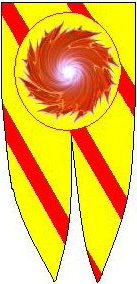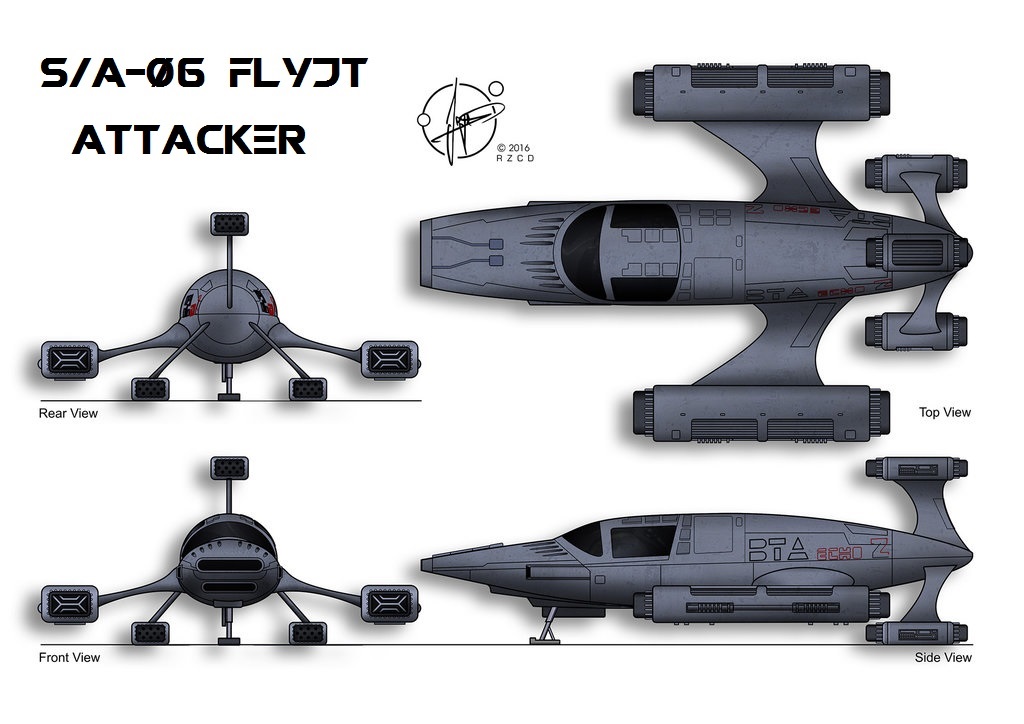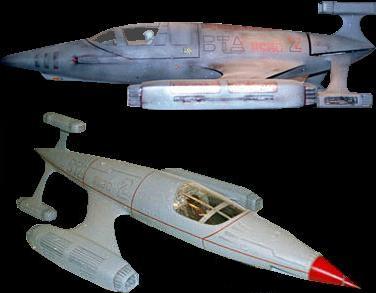
Fljyt March. | S/A-06 Flyjt Attacker. | 
Fljyt March. |
|---|
| The Flyjt were major members of the Sentinel Alliance, though minor players compared with "The Big Six" (Garudans, Perytonians, Carbonarans, etc). They were also aggressive as Hell, committing to kamikaze attacks willingly to destroy the Invid (until they linked up with the Plenipotentiary Council who banned the practice); This left them a little bitter afterwards, when the REF and Sentinel Alliance refused to take on the Atorians Empire with the same zeal that they had taken on the Invid.When the War with the Atorians finally DID come, the Flyjts threw themselves into that War with the same zeal they'd taken on the Invid; After their homeworld was liberated, they remained in the fight; Indeed, not a single Flyjt set foot on their homeworld. Instead, they formed up to moved on to the next world. When the final assault on Fehran loomed, the Flyjts were not given orders into the assault; There were so many troops already going, they were considered unnecessary. Rather than being grateful for the rest, the Flyjt commander stormed into General HUNTER'S compartment and accused him of betraying the Flyjts. Orders into combat were cut right then and there.The Flyjts had a aero-space fighter at the time of the invasion of their homeworld, which they had thought would serve them well; Unfortunately, they were wrong. A few of these survived the 400-odd years to be examined by REF engineers. Though the Flyjts themselves would say it was just a heritage piece, the REF engineers saw the potential for a space attacker, dedicated to destroying Atorian space stations. After a power plant upgrade and armor overhaul, and a after experimenting with the weapons systems configuration, the Flyjt became a permanent part of the Robotech Expeditionary Forces arsenal. When they became outdated as attackers, the REF converted them to Medical Transports, with the capacity to carry up to 20 personnel in LP-5's (30 if they are non-critical and sedated), 22 on litters, or 25 sitting, along with a dedicated crewmember, and to carry medical supplies to front line and near-front position (up to and including "DID THAT [usually Fljytish expletive] JUST SHOOT AT ME?! OH NO HE DIDN'T!!" close). These deliveries can bring up to 50 LP-5's (they're just stacked up and griped down on the aft bay).The Flyjt is in moderate use with the REFs in this capacity, but remain in Robotech Defense Forces' in defensive squadrons, deployed in scrambles when the presence of raiders is detected. They're also used in servicing AToN (typically an RDF duty). The UGC keeps these in service mainly for their association with the Atorian War, a pointed reminder to one and all just HOW serious the IPA and her successors were (are) about their position.The development of the ASF-21 Sholagar Fighter has not threatened the S/A-06 Flyjt's continued existence in the slightest; On the contrary, there are considerations to build new S/A-06's for enhanced support roles as inflight refuelers, AWACS and radar suppression, and related roles, freeing up Sholagar's for pure weapons platforms, potentially making it the longest serving aero-space platform since the fall of the Haydonite Empire.Name: FlyjtModel Type: AttackerClass: S/A-06Crew: Two.Passengers: One IS possible, but is NOT recommended.MDC By Location: |
* Fuselage-
** Cockpit-
*** Variable Rear Thruster-
*** Wings (2)-
*** Tailerons (3)- | 200
150
150
100 each
100 each | *** Grav Pod (1)-
MRM Launcher Pods (2; wing mounted)-
Landing Struts (3)-
Laser Cannons- | 10
50 each
10 each
50 each |
| Notes:* Depleting the MDC of the fuselage of the aircraft will destroy it. Pilot automatically ejects in his Patroller power armor which serves as his parachute.** Depleting the MDC Cockpit will expose the pilot to high-velocity winds and further direct attacks. However, the pilot remains protected by his power armor. (Winds won't affect him if the face mask is in place.)-5 to strike.*** Depleting the MDC of any of these objects will reduce the pilot's control (-10% to pilot skill each). The are also small and hard to hit (requires a called shot at-5 to strike). Destroying ALL 3 grav pods will force the pilot to pilot the craft on airfoil effect ONLY (-5% to pilot skill, but does not mean s/he will crash land).Speed and Statistical Data: |
Taxiing on the ground: 10 MPH
Range On Land: About 1 mile normally; 10 miles max.
Flying: Mach 20
Combat Radius: 100,000 miles. Can be refueled in the air.
Height: 10 feet
Wingspan: 20 feet
Length: 100 feet
Weight: 20 tones | Cargo: Pilot's emergency gear only. All pilots must wear flight armor when flying.
Power System: Single Gimble-Mounted RET-47 Hydro-Cell Rocket Engines;Output: 25.8million lbf; Range: 2 million minutes.
Flight Systems: Grav Pods
Cost and Availability: 10 millioncredit each; 1 months to build.
Black Market Cost and Availability: Between 1,000 and 250 millioncredit, depending on buyer and seller; Occasionally available.
|
| Weapons Systems: |
|---|
1. Nose-Mounted Laser Auto-Cannon:The original laser was a native design; During the period between the invasion, an Ator design was used. However, after linking up with the REF an new laser design was installed, based on a slightly cut down version of the MAC II's laser arms. Only one is installed, whereas the original design had 2 lasers. Never the less, this is a significant improvement in firepower.
Purpose: Anti-Bomber/Ship.
MD: 2D6 times 10 per blast.
Range: 8 miles.
Rate of Fire: Per pilot's attacks per melee.
Payload: Unlimited.
2. Ventral SRM Launcher: Adopted from the Spacer II Space Fighter.
Purpose: Anti-Missile Defense
Missile Type: Short Range.
MD and Range: Varies by type used
Rate of Fire: Volleys of 2, 4, 5, or 10 times pilots attacks per melee.
Payload: 40
Cost: 3,000 credits each.
Availability: Routinely available
3. MRM Launchers: Mounted on the wings.
Purpose: Anti-ship
MD and Range: Varies by type used.
Rate of Fire: Volleys of one per pilot's attacks per melee.
Payload: 10 missiles.
4. Partial-Barrier Force Field: The Flyjt Attacker is HIGHLY vulnerable to attacks from behind. With this in mind, it has been equipped with a shield system to cover this area. The field actually generates a "bubble" of 10 feet.
Purpose: Defense.
MDC: 250; Regenerates 10 MDC per hour WHEN NOT BEING ATTACKED.
Range: 10 feet; Will also deflect or stop all bursts while active.
NOTE: The shield is able to regenerate 1 MDC per every 6 minutes the Flyjt is not in combat; However, once the shields have been destroyed, the field generator must be replaced. | 5. Wing Mounted Weapons Systems: The Flyjt can carry up to 4 pods.A) Type M-7 Rocket Launcher: 24 2-inch rocket tubes in 12 rows of 4 each. Each rocket tube has 4 rockets.
Purpose: Heavy Assault
MD: Each rocket does 2D6 MD
Rate of Fire: Volleys of 6 or 12 times pilots attacks per melee.
Range: 12,000 feet
Payload: 96 per pod. Up to 6 pods can be carried.B) External MRM launchers (4): Mainly for shooting down hostile aircraft, though are excellent for shooting down MRM's and LRM's.
Primary Purpose: Anti-Aircraft
Secondary Purpose: Anti-LRM.
Damage: Varies by type used.
Rate Of Fire: Volleys of 1, 2, 3, or 4 per pilots attacks per melee.
Effective Range: Varies by type used.
Payload: 32 (4 per launcher, 6 pods per wing).C) M-12 Fuel Pod: Essentially a modified version of the M-11 Torpedo Pod. In this case, however, it is used as a fuel pod to double the normal range of the craft.D) A-11 Tracker Pod: This simple 63 foot pod is an expanded version of the XTNDR RADAR/Radio Antenna Extender used on almost all UGC Destroids; The A-11 is a 25 lb. pod, released to fly independently within a 100 feet of the fighter. A laser communications system relays the data collected from the A-11 Pod to the craft's computers. Because it is so much larger than the XTNDR Pod it can have a grav pod without interfering with most sensors.MDC By Location:
Pod: 70
Full-Force Barrier Field: 100
Grav Pod: 50
Effect: Effectively serves as a second fighter (for sensor purposes), giving a second viewing area, doubling or tripling sensor area 3 to 4 times (or defeats other penalties in a 5 mile area). The A-11 has all the same sensors as an EC-66, except MRI and radar; The radar is a combat grade radar, with a range of 20 miles and tracking ability of 50 targets and an 80% reliability (10% against unfriendly stealthed vehicles). This system also gives the fighter a second view angle, so unfriendly stealthed vehicles can't hide AS easily (roll against the plane AND any pods in the air at +10% each).E) A-11/a Anti-Radiation Pod: A radar and other detection system jammer.
Effect: While active, enemy radar will have a "wash" effect, where a large, highly unstable cloud of radar paint will appear. An experienced (5ᵗʰ level and above) radar operator can SOMETIMES use the flow of the wash to narrow down the source of the jamming, but typically this does little good. NOTE: This IS a form of radar signal, and can therefore by tracked by some ESM systems (-10%).F) A-11/v Radiation Detector Pod: This pod passively detects various types of Radiation, most importantly radio signals (for eavesdropping).G) C-441 Canister Pod: Basically a hollowed out version of the TM-7 pod, used to drop highly sensitive and extensive messages. A nose-mounted device using GPS or laser detection guides the pod to within ⅛ᵗʰ of an inch of the intended target. |
| Medical Transport:The S/A-06 Flyjt's efficacy as a combat platform was long gone by the time they enterd REF service; In fact, their inefficacy was a partial reason for Flyjt's defeat by the Atorian Empire. When the REF finally managed convince the UWA alliance the craft simply could not compete on the battlefield, the Council ordered tehm "retrofitted as best as circumstances allowed" and remain in active service; The medivac transport conversion was seen as the most practical under the circumstances. They can carry 50 LP-5's to the front area and 20 back (30 for sedated non-critical), or 22 littered or 25 sitting personnel on litters (or combination thereof). |
| Features: |
- Radar: Combat grade radar. Range: 200 miles, can track up to 250 individual targets. 95% reliability (24% against unfriendly stealthed vehicles).
- ESM: Radar Detector. Passively detects other radars being operated.
- Full Range Sensory Suite: Infrared, ultra violet, Magnification, night sight, color filters, thermal imager. Range is about 2,000 miles for MOST sensors.
- Optic Sensors Systems: The craft is equipped with sensors all the normal combat aircraft sensors. NOTE: that the sensors on this craft is nowhere near as extensive as those on spycraft.
- Optic Systems: Infrared: 20 miles; Magnification: 15 times; Ultra Violet: 22 miles; Magnification: 25 times; Night Vision: 24 miles; Magnification: 8 times; Color Filters: 19 miles; Magnification: 200 times; Thermal Imager: 10 miles; Magnification: 40 times
- Motion Detector: Activates a loud wailing when an object is coming at the user fast, and a soft ringing if it's coming slowly. Activation ranges must be specified by the pilot.
- FLIR/SLIR: Forward and Side Looking Infrared. Allows pilot and weapons officer to get visuals on targets at night.
- Video Recorder: Records from sensors and the cockpit itself. 500 hours of recording available.
- HUD: Displays maps, radar, targeting information, and any OTHER information the wearer wants directly in front of the user.
- AMC/FD (2): Anti-Missile Chaff/Flare Dispensers. Actually launches a glob of burning magnesium/aluminum alloy to confuse both radar AND heat sensory systems. Fires off 04 chaff/flares each time it is activated. The system is KNOWN to work on all KNOWN radar and infrared systems, but concerns continue that somewhere out there their MIGHT be a system that will be totally unaffected by the system. Reduce effects by 20% against smart missiles (add +20% to rolls for smart missiles).
- Effect:
- 01-50: Enemy missile or missile volley detonates in chaff cloud- Missiles are all destroyed
- 51-75: Enemy missile or missile volley loses track of real target and veers away in wrong direction (may lock onto another target).
- 76-00: No effect, missile is still on target.
- Also note that the chaff cloud will also blind nearby heat sensors (and optically based sensors at night) for 1 melee. They will suffer the following penalties: Reduce melee attacks/actions, and combat bonuses by half.
- Duration: 1D4 melee rounds.
- Payload: 60 chaff/flares. Each time the system is engaged, the system fires off 04 chaff/flares.
- MRA 6 Radios: Allows real time, continuous radio link up with friendly forces in the area via satellite relay over laser radio signals, preventing jamming, and automatically encrypts/decrypts same to prevent eavesdropping.
- Type-11 wide band radios: Effective 10 mile range, auto encrypt/decrypt. Works on standard radio band wavelengths, so it can still be jammed (if the enemy knows the frequencies).
- Combat/Targeting Computer: Records all enemy and friendly activity over the course of time; Can replay that activity for the pilot, assign target designation numbers, and track likely damage based on mathematical formulas (i.e. "Right leg red" badly damaged/destroyed, "head green" not damaged, etc). Displays this information as a pop up in the HUD on request by the pilot.
- Smoke Dispensers (8): Throws out smoke flares capable of covering a 2503 foot area. Special chemicals in the smoke obscures IR and heat sensors, and defeats visual tracking of the vehicle. Note that it DOESN'T make the vehicle invisible, but simply negates ALL bonuses to strike.
| - AJP: Active Jamming Pod. Causes-25% to detection but when it is active, other vehicles/bases can detect that it is jamming, and some missiles will home in on jamming signals. Jamming also causes a-4 penalty to all radar guided weapons.
- Blue Force Tracker: Identifies Friend from Foe. Overlays the information on both the radar and HUD, ensuring that friendly forces are not accidentally targeted.
- CBR Protection: Complete chemical, biohazard, and radiological protection.
- Anti-Jamming System: Reduces Electronics Countermeasure by 3/4 (decrease skill level appropriately).
- Electronic Counter Measures (ECM): These systems disrupt enemy radar and tracking systems, making it difficult for them to lock onto the ship with weapons. The countermeasures give the Mecha a +3 to dodge, +2 to strike and +1 on initiative in combat.
- Vacuum Seal: Permits the fighter to be used in hard vacuum (such as outer space), and other hostile environments.
- Internal temperature and humidity control: Automatically maintains users desired heat, humidity, and other personal comfort settings.
- Heat And Radiation Shielding: Special shielding prevents the penetration of life threatening heat and radiation.
- Variable Tint Cockpit Canopy: Adjusts tinting to light conditions, up to an including a black dot if the sun is directly on the pilots face (only covers eyes).
- LDP (4): Launched Decoy Pods. Located on the top of the port and starboard wingtips. The fighter can carry a special pod that carries four advanced decoy drones. These drones are launched to go where ever they want for 30 minutes. Each is a specially designed radar lure that creates a radar image to mimic the fighter. If decoys are not destroyed, they can be recovered and repaired. This system has been successfully deployed against SEVERAL alien radar-type sensors (including one that works off of sound).
- MDC: 5
- Effects: The decoy has a 98% chance of fooling ordinary non military radars and non smart guided missiles, and a 90% chance of fooling military grade radars and advanced smart missiles.
- Range: Towed to 328 feet (100 meters) from the Mecha or released to go wherever it wants. Can fly independently for about 30 minutes.
- Rate of fire: One can be tether deployed at a time and requires 15 seconds to deploy another decoy. Any non-loosed decoys can be reeled in again.
- Payload: 16 Decoys total.
- Survival Pack: A pack of simpler emergency survival supplies: Pup tent, sleeping bag, black light, GPS, First aid kit (bandages, gauze, bandage tape, pads, antiseptic/analgesic), plasma torch (for small repairs and starting fires), repair kit (with MDC Repair Spray), sewing kit (a small spool of thread and 5 needles), 7 star flares (250 foot apogee), 7 white parachute flares (1,500 foot apogee), 100 foot of black or brown parachute cord (150 lbs tensile strength), 2-5 days rations, 2 gallons water, water purification kit (good for about 10 gallons), manual-inflating liferaft (for at-sea abandonment), self-inflating lifevest (15# buoyancy). The liferaft can also double as a Pup Tent if so desired (though most pilots prefer to use a parachute for that, if anything, due to the fact that it is easier to hide).
- Oxygen Rebreather System: Extends pilots air supply to 100 hours; Cartridge MUST be replaced after that period of time.
- GPS: Standard tracking device.
- Virtual Map: Displays a continuously-updating map of local terrain for the pilot. Effective land navigation of 85% as updates come. Good to 50 miles. Specific range can be adjusted in 1 mile increments.
|
Combat Bonuses from S/A-06 Flyjt Attacker Combat Elite:- 3 additional attacks per melee.
- One additional Attack Per melee at levels 3, 6, 9, 12, 15, and 18 with any additional bonuses for the pilot.
- +5 Initiative.
- +7 Strike.
- -3 Dodge (it's very difficult to DODGE in this craft).
- +15 Roll (which will only HALVE damage, not avoid it all).
|



